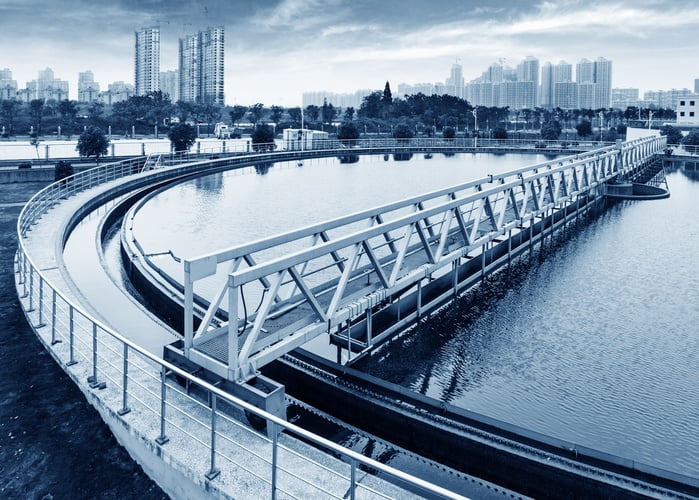5 Unique Considerations for Electrical Enclosures in Water Treatment
 Water treatment plants represent an unusual combination of predictable and somewhat unpredictable conditions that result in a hostile environment for electrical equipment. Although there are similarities between potable and wastewater treatment, the added hazards of human and industrial waste mean that environmental conditions at wastewater treatment plants are more difficult.
Water treatment plants represent an unusual combination of predictable and somewhat unpredictable conditions that result in a hostile environment for electrical equipment. Although there are similarities between potable and wastewater treatment, the added hazards of human and industrial waste mean that environmental conditions at wastewater treatment plants are more difficult.
This is due to the presence of contaminated water, corrosive liquids and vapors well as flammable gases generated by the decomposition of waste. Rodents represent an additional hazard. Altogether, five unique considerations exist.
1. External Protection against Corrosion
Despite the fact that treatment plants are largely outdoors, industrial effluent may contain a range of corrosive chemicals. Additionally, vapors such as hydrogen sulfide may be generated during decomposition of human waste and these play havoc with unprotected carbon steel structures. Various chemicals used during water treatment are highly corrosive, even in relatively low concentrations. These include chemicals like sulfuric acid, chlorine, hydrogen peroxide and ammonia.
These chemicals attack carbon steel, and even copper is not immune, so the only practical solution is to construct electrical enclosures from stainless steel. To protect other surfaces, such as air conditioning unit coils, electrostatically applied epoxy coating needs to be applied so that nothing is exposed to chemical attack.
2. Internal Protection from Chemical Liquids and Vapors
Apart from the need to protect enclosures against external corrosion, electrical equipment inside enclosures is vulnerable. Moving parts and base plates are often made using corrosion-susceptible carbon steel support structures. Electrical contact material may be tarnished and suffer corrosion, leading to contact overheating and burning and low voltage contacts can fail to close.
Consequently, electrical enclosures should be fully sealed to keep corrosive vapors and liquids out. However, the sealing of electrical enclosures creates another problem, that of overheating. This is due to inadequate heat dissipation, so in most cases, electrical enclosures need to be fitted with closed loop enclosure cooling solutions.
3. Surface Contamination, Splashing and Wash Downs
It is inevitable that a certain amount of splashing will occur, and the presence of aerosols containing organisms is likely. As a result, surfaces such as enclosure doors may become contaminated with harmful bacteria and organisms. Additionally, there’s the risk that electrical enclosures could be subject to direct water spray by contaminated water. Enclosures should resist the ingress of water as a result of direct water impingement and also be capable of being hosed down.
4. Flammable Gases
Decomposition of waste generates methane and a certain amount of hydrogen. Research shows that relatively high concentrations of these flammable gases can be present. Some chemicals used for water purification are themselves potentially flammable and explosive under certain conditions. Good examples are chlorine dioxide and hydrogen peroxide.
Electrical enclosures located in any area where explosive concentrations of flammable gases may collect, even under abnormal conditions, must be flameproof and fitted with enclosure coolers designed for use in hazardous locations.
5. Rodents
Rodents represent a unique problem in waste water treatment plants. They are attracted by the presence of decomposing matter, sludge and water. They also seek out quiet warm places for dens, so it’s essential that any electrical enclosures located in places where rodents are likely to be present should be designed to be inaccessible. All cables entering these enclosure should be well protected and in conduits.
An Optimal Solution for Waste Water Treatment Plants
To adequately protect electrical enclosures in wastewater treatment plants from these five unique considerations, the enclosures should be:
- Made of corrosion-resistant material
- Totally sealed against liquid and vapors
- Able to withstand splashing and water jets
- Impenetrable by rodents
- Flameproof in some locations
These requirements are best met through selecting a NEMA Type 4X enclosure. Also, electrical enclosures should be fitted with a specially designed closed loop enclosure cooler that is designed to withstand the harsh environmental conditions present in wastewater treatment plants. It’s imperative that electrical equipment is maintained at a safe working temperature, even under the hottest ambient conditions.
Selecting the Right Enclosure Cooler
Thermal Edge, located in Irving Texas, specialize in the design and manufacture of high quality, no-nonsense, robust enclosure cooling solutions that are ideally suited to the harsh environment of water treatment plants. Coolers designed for harsh environments are supplied with seam welded stainless steel housings and are available with optional coil corrosion protection. Condenser coils can also be protected by high-capacity stainless steel filters that ensure excellent air flow, are resistant to chlorine exposure and keep rodents out. To find out more, contact your local Thermal Edge Sales Representative.

